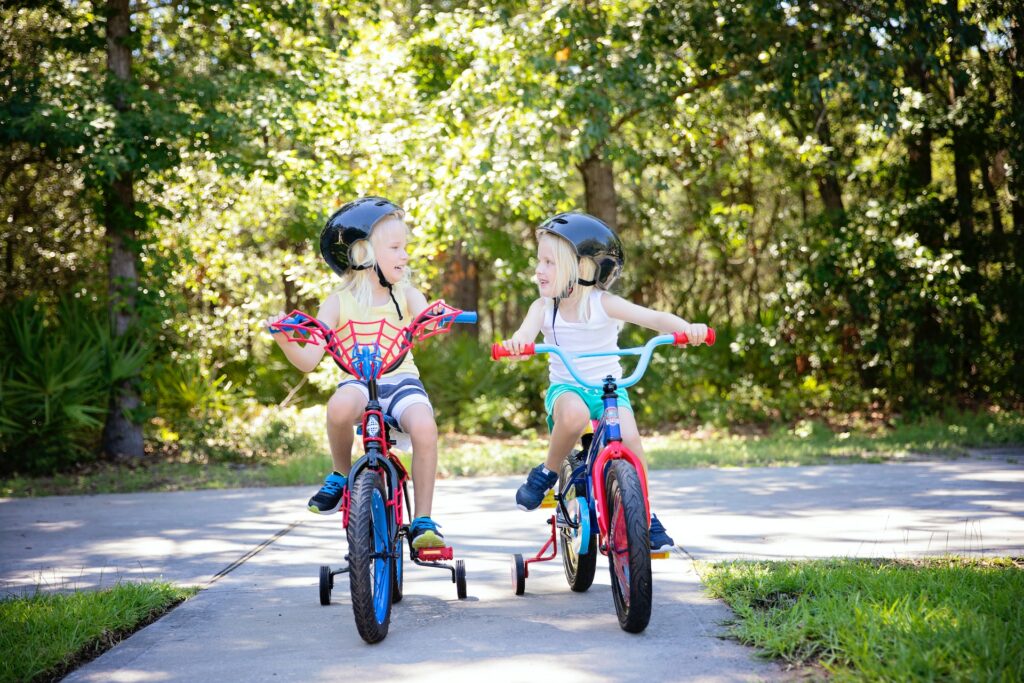Witnessing the gleeful moment when a child pedals a bicycle for the first time is a cherished memory for many parents. The journey to becoming a skilled bike rider is a significant milestone in a child’s life, fostering a sense of independence and accomplishment.
If you’ve ever wondered, “At what age do kids learn to ride a bike?” you’re in the right place. This comprehensive guide will not only answer your question but also provide insights into the various stages of bike riding readiness, empowering you to support your child’s biking adventure.
Key Developmental Stages
Early Explorations (2-3 years)
The bike riding journey begins with the simplest of activities: balancing. Even before hopping on a bike, toddlers develop essential motor skills through activities like walking, running, and playing with ride-on toys.
Encourage their confidence by introducing a balance bike – a pedal-less bike that helps them focus on stability and steering. These early experiences lay a solid foundation for their future biking endeavors.
Training Wheel Time (4-5 years)
As children reach preschool age, their motor skills advance, and they become more curious about bikes. This is an ideal time to introduce a bike with training wheels. Training wheels provide stability and build their confidence while allowing them to get a feel for pedaling.
Remember, each child’s progress is unique; some might need more time to master the balance, while others may quickly move on to the next stage.
Parental Guidance and Encouragement
Patient Support and Encouragement
Parental involvement plays a pivotal role in a child’s biking journey. Be patient and encouraging, providing a safe and open space for them to learn at their own pace. Offer a helping hand when needed, but also allow them to experience small challenges that foster determination and resilience.
Practice Makes Progress
Regular practice is key to honing bike riding skills. Find a flat, open area free from traffic where your child can practice steering, balancing, and pedaling. Gradually increase the complexity of the terrain as their confidence grows. Celebrate their milestones, whether it’s a longer ride or smoother turns, to boost their self-assurance.
The Right Age and Building Confidence
Varied Readiness (6-8 years)
Children’s readiness to ride a bike varies. Around ages 6 to 8, many kids are physically and mentally prepared to transition to a two-wheeled bike. However, it’s essential to focus on their individual progress rather than a strict age range. Some may be ready earlier, while others might need more time. Observe their motor skills, confidence, and interest to determine the optimal time for this exciting step
Exploring Advanced Skills and Safety Measures
Mastering Bike Riding Techniques (9-12 years)
As children enter their pre-teen years, they often become more adept at bike riding. They can handle more complex maneuvers, such as navigating turns, braking effectively, and riding on uneven surfaces. Encourage them to explore their local neighborhood or parks, gradually expanding their riding territory while reinforcing safety rules.
Prioritizing Safety Always
While the excitement of bike riding is palpable, safety should always be a top priority. Equip your child with a properly fitting helmet – a non-negotiable accessory that protects their head in case of a fall.
Teach them the importance of looking both ways before crossing the road and using hand signals to indicate turns. Emphasize the significance of wearing bright clothing and using reflectors, especially when riding during low-light conditions.
Learn how to teach your kid to ride a bike in a mountain trail, watch this video
Fostering Lifelong Biking Enthusiasm
Family Bike Adventures
Cultivate a love for biking by engaging in family bike adventures. Plan outings where the whole family can participate, exploring scenic routes, parks, or even nearby trails. These shared experiences not only promote bonding but also create lasting memories centered around physical activity and exploration.
Learning Bike Maintenance
Teaching your child basic bike maintenance is a valuable life skill. Show them how to perform routine checks, such as inflating tires, tightening bolts, and oiling the chain. This not only ensures a safe ride but also empowers them to take responsibility for their possessions.

Conclusion
From the first wobbly attempts at balancing to the confident pedaling of a skilled rider, a child’s journey to learning how to ride a bike is filled with growth, challenges, and joy.
While the question “At what age do kids learn to ride a bike?” may not have a one-size-fits-all answer, the stages and milestones discussed in this guide provide a roadmap for parents to navigate their child’s biking adventure.
Remember that every child is unique, and their progress will unfold in its own time. By providing unwavering support, fostering a safe environment, and promoting a love for biking, you’re not just helping them conquer a physical skill – you’re instilling life lessons in determination, resilience, and exploration.
As your child embarks on this exciting journey, be their biggest cheerleader, celebrating every achievement and milestone along the way.
